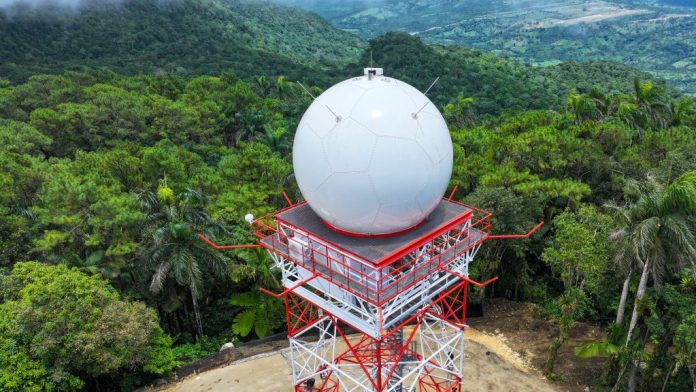The state-of-the-art modern C-band equipment will anticipate atmospheric phenomena and ensure greater air and public safety.
Three additional radars will be integrated at the AILA, Cibao, and Cabo Rojo airports, in addition to the one installed in Punta Cana.
Puerto Plata – The Dominican Institute of Civil Aviation (IDAC) has put into operation the dual-polarization, solid-state Doppler Weather Radar Band C at the emblematic Loma Isabel de Torres in Puerto Plata. With this action, the government aims to continue advancing the modernization of the national meteorological system and strengthening operational safety in Dominican airspace.
The event was led by the Minister of the Presidency, José Ignacio Paliza, and the general director of IDAC, Igor Rodríguez Durán, who highlighted the strategic importance of this new equipment within the framework of the technological transformation that the country is experiencing in risk management and air navigation systems.
“President Luis Abinader has tasked us with moving forward with firm steps in the modernization of the country, and this radar is a demonstration that this commitment translates into action. With this new technology, we reinforce the State’s ability to protect lives and optimize aerial operations with precise, real-time data,” affirmed Minister Paliza.
For his part, Igor Rodríguez explained that the new WRS300 radar has an effective coverage of 250 km and a total range of up to 400 km, which will allow the country to monitor phenomena such as hurricanes, thunderstorms, heavy rainfall, and other high-impact atmospheric events with greater precision.
“This technological tool will strengthen our compliance with our responsibilities to the ICAO and ensure safer and more efficient aerial operations,” he indicated.
Rodríguez announced that the team will be integrated into a national network along with the radar already installed at Punta Cana International Airport, another that will be inaugurated soon at Las Américas Airport (AILA), and two more planned for the Cibao and Cabo Rojo airports, which will allow for coverage of the entire national airspace under the coordination of the IDAC and INDOMET.
The director of INDOMET, Gloria Ceballos, evaluated the incorporation of this technology as a vital tool for the timely issuance of early alerts to the population and for the planning of public policies in response to natural phenomena.
The event was also attended by the director of the COE, Juan Manuel Méndez; governor Claritza Rochtte; senator Ginette Bournigal; mayor Roquelito García; representative Fiordaliza Estévez; the secretary of the Civil Aviation Board (JAC) Bernarda Franco; Major General Pilot Floreal Suárez Martínez, commander of the Dominican Republic Air Force, as well as authorities from the national aviation sector.






























